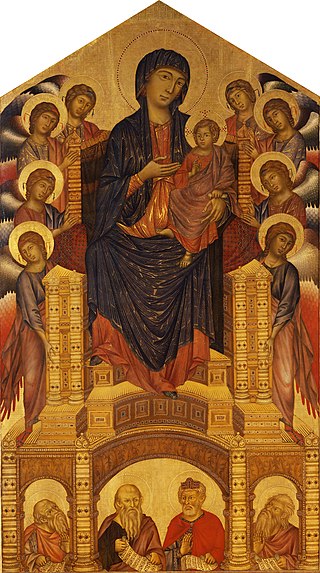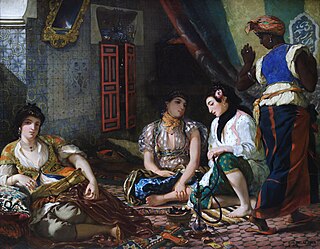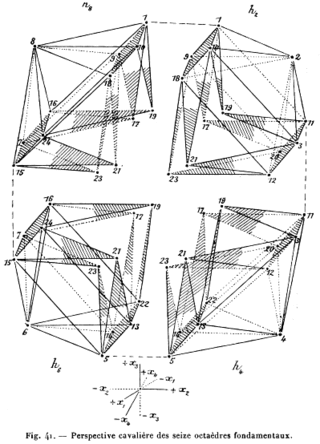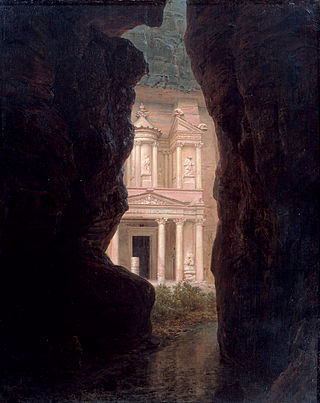A detail is an isolated element within a work of art, particularly from a painting, sculpture or building. [1]
A detail is an isolated element within a work of art, particularly from a painting, sculpture or building. [1]
A detail is distinct from the general composition of a work of art. [1] The art historian Jennifer Raab of Yale University describes it as inherently contradictory: "it can delineate difference or emphasize unity". [2] She furthers that "the detail always points away from itself to something else–to other parts of a picture, to the work of art as a whole". [2]
When a detail is reproduced, this is noted in the work of art's caption. [2]

Cimabue, c. 1240 – 1302, was an Italian painter and designer of mosaics from Florence. He was also known as Cenni di Pepo or Cenni di Pepi.

Impressionism was a 19th-century art movement characterized by relatively small, thin, yet visible brush strokes, open composition, emphasis on accurate depiction of light in its changing qualities, ordinary subject matter, unusual visual angles, and inclusion of movement as a crucial element of human perception and experience. Impressionism originated with a group of Paris-based artists whose independent exhibitions brought them to prominence during the 1870s and 1880s.

Romanticism was an artistic and intellectual movement that originated in Europe towards the end of the 18th century. The purpose of the movement was to advocate for the importance of subjectivity, imagination, and appreciation of nature in society and culture during the Age of Enlightenment and the Industrial Revolution.

Joseph Mallord William Turner, known in his time as William Turner, was an English Romantic painter, printmaker and watercolourist. He is known for his expressive colouring, imaginative landscapes and turbulent, often violent marine paintings. He left behind more than 550 oil paintings, 2,000 watercolours, and 30,000 works on paper. He was championed by the leading English art critic John Ruskin from 1840, and is today regarded as having elevated landscape painting to an eminence rivalling history painting.
Michael Martin Fried is a modernist art critic and art historian. He studied at Princeton University and Harvard University and was a Rhodes Scholar at Merton College, Oxford. He is the J.R. Herbert Boone Professor Emeritus of Humanities and Art History at the Johns Hopkins University, Baltimore, Maryland, United States.

The Camden Town Group was a group of English Post-Impressionist artists founded in 1911 and active until 1913. They gathered frequently at the studio of painter Walter Sickert in the Camden Town area of London.
Francis James Herbert Haskell, was an English art historian, whose writings placed emphasis on the social history of art. He wrote one of the first and most influential patronage studies, Patrons and Painters.

Women of Algiers in their Apartment is the title of two oil on canvas paintings by the French Romantic painter Eugène Delacroix.

Martin John Kemp is a British art historian and exhibition curator who is one of the world's leading authorities on the life and works of Leonardo da Vinci. The author of many books on Leonardo, Kemp has also written about visualisation in art and science, particularly anatomy, natural sciences and optics. Instrumental in the controversial authentication of Salvator Mundi to Leonardo, Kemp has been vocal on attributions to Leonardo, including support of La Bella Principessa and opposition of the Isleworth Mona Lisa.

Woman with a Hat is an oil-on-canvas painting by Henri Matisse. It depicts Matisse's wife, Amélie Matisse. It was painted in 1905 and exhibited at the Salon d'Automne during the autumn of the same year, along with works by André Derain, Maurice de Vlaminck and several other artists later known as "Fauves".
Ian Lorne Campbell is a Scottish art historian and curator. Campbell was Beaumont Senior Research Curator at the National Gallery, London from 1996 to 2012, and from 1974 to 1996 lectured on the Northern Renaissance at the Courtauld Institute of Art, University of London. He has curated major exhibitions at the National Gallery and other museums, including ones on Rogier van der Weyden at Leuven in 2009 and the Prado in 2015.

New possibilities opened up by the concept of four-dimensional space helped inspire many modern artists in the first half of the twentieth century. Early Cubists, Surrealists, Futurists, and abstract artists took ideas from higher-dimensional mathematics and used them to radically advance their work.

The Icebergs is an 1861 oil painting by the American landscape artist Frederic Edwin Church. It was inspired by his 1859 voyage to the North Atlantic around Newfoundland and Labrador. Considered one of Church's "Great Pictures"—measuring 1.64 by 2.85 metres —the painting depicts one or more icebergs in the afternoon light of the Arctic. It was first displayed in New York City in 1861, where visitors paid 25 cents' admittance to the one-painting show. Similar exhibitions in Boston and London followed. The unconventional landscape of ice, water, and sky generally drew praise, but the American Civil War, which began the same year, lessened critical and popular interest in New York City's cultural events.
The False Mirror (1928) is a surrealist oil painting by René Magritte that depicts a human eye framing a cloudy, blue sky. In the depiction of the eye in the painting, the clouds take the place normally occupied by the iris. The painting's original French title is Le faux miroir.

Niagara is an oil painting produced in 1857 by the American artist Frederic Edwin Church. Niagara was his most important work to date, and confirmed his reputation as the premier American landscape painter of the time. In his history of Niagara Falls, Pierre Berton writes, "Of the hundreds of paintings made of Niagara, before Church and after him, this is by common consent the greatest."

The Andes of Ecuador is an 1855 oil painting by Frederic Edwin Church, the premier American landscape painter of the time. It is the most significant result of his 1853 trip to South America, where he would travel again in 1857. It is Church's first major painting, his largest work to date, and "an early masterpiece of Luminism", according to the Reynolda House Museum of American Art in Winston-Salem, North Carolina, which holds the painting.

El Khasné, Petra is an 1874 oil painting by American landscape artist Frederic Edwin Church. It is a depiction of the Al-Khazneh temple in the historical city of Petra, Jordan, which Church visited during an extended trip to the Middle East and Europe in 1867 and 1868. He visited the tomb with American missionary D. Stuart Dodge in February 1868 and made sketches there. The painting is located at Olana State Historic Site, the preserved homestead where Church lived in his later years. It may be the last canvas that he painted entirely with his right hand, owing to worsening rheumatoid arthritis.

The Temple of the Gadde is a temple in the modern-day Syrian city of Dura-Europos, located near the agora. It contained reliefs dedicated to the tutelary deities of Dura-Europos and the nearby city of Palmyra, after whom the temple was named by its excavators. The temple was excavated between 1934 and January 1936 by the French/American expedition of Yale University, led by Michael Rostovtzeff.

The scutum from Dura-Europos is the only surviving semi-cylindrical shield (scutum) from Roman times. It is now in the Yale University Art Gallery. The shield was found in the excavation campaign of 1928/37 on Tower 19 of Dura-Europos. The city was besieged by the Sassanids in 256, eventually captured and destroyed. The dry climate enables very good conservation conditions for organic materials such as wood. Since the city housed a Roman garrison and was lost during a siege, a particularly large number of weapons were found during the excavations.

The building that is referred to as the Priests' House, or House of Priests, at Dura-Europos near the village of Salhiyah in eastern present-day Syria, is one of three buildings that was excavated in block H2. It is hypothesized to be the home of priests from the Temple of Atargatis based on its proximity to the two neighboring temples and graffiti found in the third Excavation season.